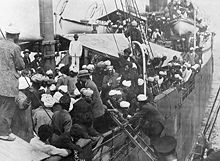 | |
| Date | May 23, 1914 |
|---|---|
| Location | Vancouver, British Columbia |
| Outcome | Ship forced out of Canada |
| Deaths | Twenty-six in government records,[a] |
| Part of the series on | ||||||||||||||||||||||
| History of Vancouver | ||||||||||||||||||||||
|---|---|---|---|---|---|---|---|---|---|---|---|---|---|---|---|---|---|---|---|---|---|---|
| History | ||||||||||||||||||||||
|
||||||||||||||||||||||
| Events | ||||||||||||||||||||||
|
||||||||||||||||||||||
| Timeline of Vancouver history | ||||||||||||||||||||||
The Komagata Maru incident involved the Japanese steamship Komagata Maru, on which a group of people from British India attempted to migrate to Canada in April 1914, but most were denied entry and forced to return to Budge Budge, near Calcutta (present-day Kolkata). There, the Indian Imperial Police attempted to arrest the group leaders. A riot ensued, and they were fired upon by the police, resulting in some deaths.[2]
Komagata Maru sailed from British Hong Kong, via Shanghai, China, and Yokohama, Japan, to Vancouver, British Columbia, Canada, on April 4, 1914, carrying 376 passengers from Punjab province in British India.[3] The passengers were 337 Sikhs, 27 Muslims and 12 Hindus, all Punjabis and British subjects.[4] Of these 376 passengers, 24 were admitted to Canada, but the other 352 were not allowed to disembark in Canada, and the ship was forced to leave Canadian waters. The ship was escorted by HMCS Rainbow, one of Canada's first two naval vessels.[5] This was one of several incidents in the early 20th century in which exclusion laws in Canada and the United States were used to exclude immigrants of Asian origin.
- ^ Report of the Komagata Maru Committee of Inquiry and Some Further Documents. Unistar Books and Punjab Centre for Migration Studies. 2007. p. 74. ISBN 9788189899349. Retrieved April 12, 2022.
- ^ "Komagata Maru". The Canadian Encyclopedia. June 6, 1944. Retrieved November 9, 2024.
- ^ "Komagata Maru incident (1914)". Dictionary of Canadian Biography. Retrieved July 27, 2024.
- ^ Johnston, Hugh (February 7, 2006). "Komagata Maru; The Canadian Encyclopedia". www.thecanadianencyclopedia.ca. Archived from the original on April 5, 2021. Retrieved April 5, 2021.
- ^ The Voyage of the Komagata Maru: the Sikh challenge to Canada's colour bar. Vancouver: University of British Columbia Press. 1989. pp. 81, 83. ISBN 978-0-7748-0340-3.
Cite error: There are <ref group=lower-alpha> tags or {{efn}} templates on this page, but the references will not show without a {{reflist|group=lower-alpha}} template or {{notelist}} template (see the help page).